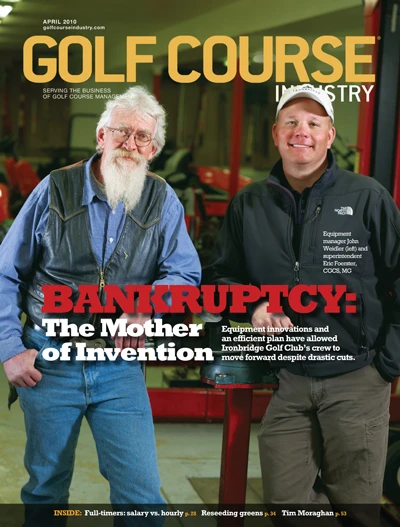<p>Tom Trammell, director of agronomy for the Doral Golf Resort and Spa put on a thicker jacket as we prepared to tour TPC Blue Monster at Doral (Fla.) in advance of his fourth World Golf Championship.</p> <p><strong>Q What is special for you about The World Golf Championship? <br /> </strong>It’s as close to a major championship as I can have. The event hosts 75 of the world’s top players representing each major golf tour from around the world. It’s perhaps the strongest field in golf and we treat it as such.</p> <p><strong>Q Tell me about the agronomic issues that concern you the week before the championship? </strong><br /> The weather has been the biggest obstacle. The cold temperatures have lingered for several weeks and affected the health and growth response of our hybrid Bermuda turfgrass putting greens and fairways. The turf is weak from the last six months of unusual weather. During the summer we encountered 50 inches of rain and constant cloud cover. Less sun and more moisture leads to thin and weak turfgrass with little recovery potential.</p> <p>In addition, due to our national economic picture, the resort opened more opportunities for play by members, resort guests and outside play, which has increased the traffic, fairway divoting and ball marks on the putting greens. Not wanting to disrupt guest play, our agronomic cultural work was decreased. The lack of routine cultural programs to strengthen the turf for winter play has set us back.</p> <p><strong>Q Describe what you and your team are currently doing to enhance your playing surfaces? </strong><br /> I always look back before moving forward in this business. Entering last year’s event we were dry and it showed during the telecast. Our first goal was to modify and enhance the irrigation system by increasing water availability through additional quick couplers coursewide. We now have access to irrigation for any droughty location, which allows for uniform playing conditions. We hand irrigate to be more precise. <br /> For the onset of the colder weather we accomplished the following for the putting greens:<br /> • Increased our foliar fertility on a weekly schedule and applied when we felt the plant would actively take in the nutrients. Without the required cultural work we are dealing with an increase in organic matter and a weakened plant.<br /> • Ceased all Primo applications seeing we had a natural growth regulation with the cold.<br /> • Increased the height-of-cut for our greens and all turf, installed solid rollers and monitored player/cart traffic. Semi-dormant turfgrass – whether cool or warm season varieties – will suffer in heavily trafficked areas.<br /> • We stopped using walk mowers and used triplex units during the coldest period.<br /> • Instituted weekly needle-tining, especially on the putting green perimeters and clean-up pass to reduce compaction. <br /> • Reviewed the shade impacts from surrounding trees and removed any offenders.</p> <p><strong>Q With an event as challenging as this, I know green speed will be an issue. What are you doing to meet PGA Tour requirements while the weather remains cold?</strong><br /> We have met their advance week specifications, but will need to gain some more speed quickly while play is still going strong. What we have done is: <br /> • Use a combination of light grooming with the groomers set slightly below bed-knife height, followed by light topdressing using the bagged sand, which is very dry and can be easily worked into the turfgrass canopy.<br /> • Incorporate light brushing of the green surface as well as vertical mowing up and back along the same pass before moving to the next cutting pass. This “back-track” vertical mowing allows us to stand up our TifEagle and remove more leaf blade without lowering height-of-cut too soon. We drop the height on a regular schedule beginning the weekend prior to the event.<br /> • Return to Primo applications at a reduced rate on a shorter schedule. <br /> • Monitor irrigation and traffic. <br /> • Monitor the weather forecast to avoid doing any cultural practice, which will damage turfgrass and impact resort play after the event has concluded.</p> <p><strong>Q Any additional tournament advice to offer? <br /> </strong>With the enormity of the championship we must coordinate our staff and be sure all assignments, times and concerns are met and accomplished on schedule without too many questions.</p> <p>We have provided all employees with their own schedules of tasks and daily events, as well as when to arrive, eat and leave the golf course.</p> <p>We request all employees wear flat shoes to reduce abrasion to the turfgrass during the colder weather.</p> <p>We do not allow any cellular phone conversations during work unless it’s to contact a member of the management team. All necessary phone numbers are provided on the schedule sheet.</p> <p>Last but not least, as each person exits the golf course at day’s end they are required to check that no flagstick or tee marker remains on the golf course lest it becomes a unique souvenir. <strong>GCI<br /> </strong></p>

Explore the April 2010 Issue
Check out more from this issue and find your next story to read.
Latest from Golf Course Industry
- Golf Construction Conversations: Reed Anderson
- ’Twas the Night Before Christmas (on turf)
- Twas the Night Before Christmas (the turf version audio)
- Advanced Turf Solutions and The Aquatrols Company release soil surfactant
- Heritage Golf Group acquires North Carolina courses
- Editor’s notebook: Green Start Academy 2024
- USGA focuses on inclusion, sustainability in 2024
- Greens with Envy 65: Carolina on our mind





